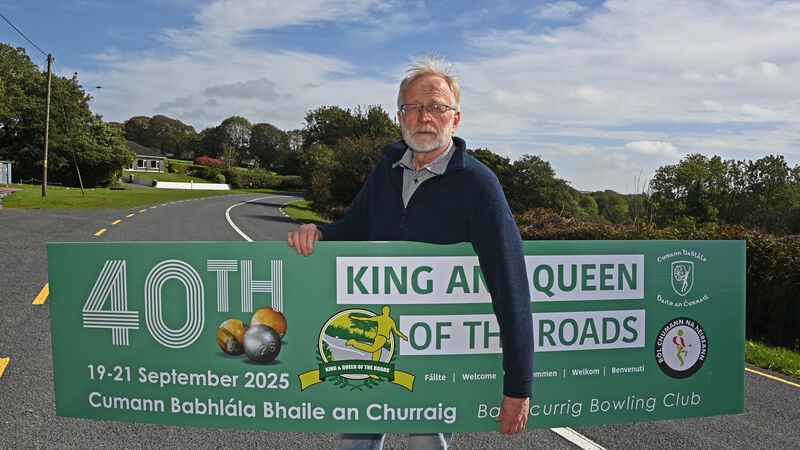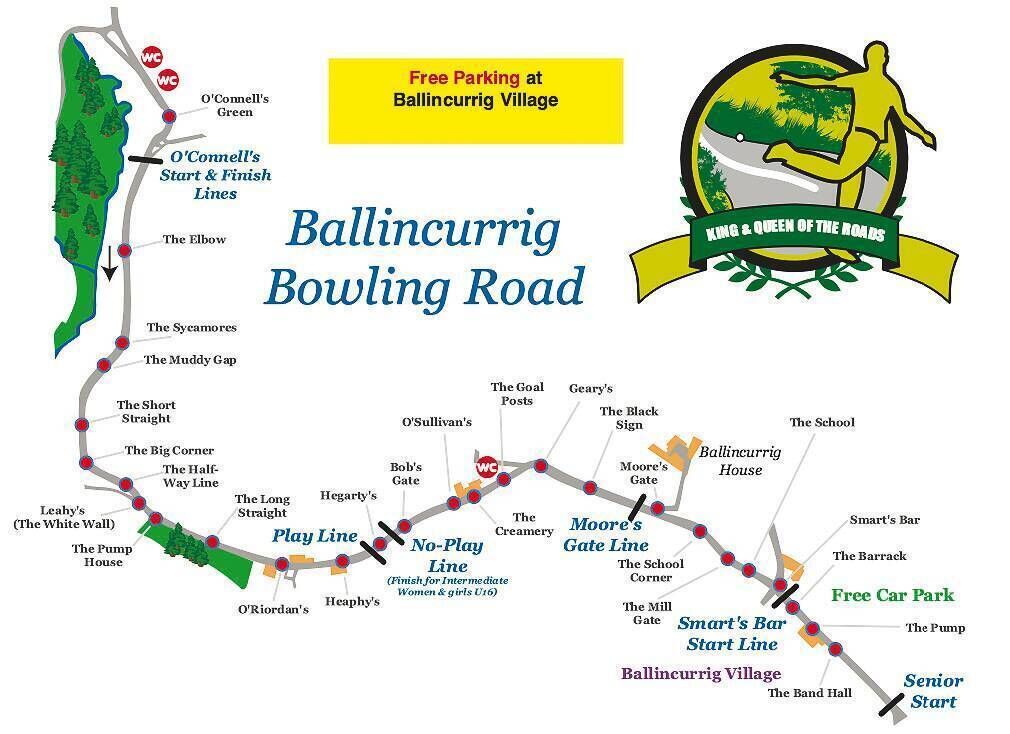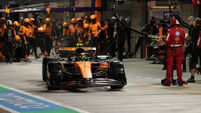Road Bowling: 40th King and Queen of the Roads brings the world to Ballincurrig's 2km stretch

FROM ALL OVER: Seamus O'Tuama, organising committee King and Queen of the roads hosted by Ballincurrig bowling club featuring players from Ireland, Germany, Netherlands and Italy this weekend. Picture: Eddie O'Hare
Last weekend, Hollywood legend Bill Murray was stood outside Smart’s Bar in Ballincurrig preparing for his road bowling debut. With the entourage of TV trucks parked along the road, it was as if Donald Trump had landed in the East Cork village.
This weekend is even bigger again. The King and Queen of the Roads festival hits its 40th anniversary. German TV will be attending. The French version of Hector is coming with his camera crew.
This two-kilometre stretch has been bowling territory for hundreds of years. Across the road from Smart’s is the remnants of an old mill. At lunchtime, the workers would go bowling. Then, they’d go up the road again after work. Man, woman, and child, everyone went bowling.
TV, radio, 4-5,000 spectators, and competitors from Munster, Ulster, the Netherlands, Germany, and Italy will crowd around that same start line from the first bowl on Friday until the big prizes are decided on Sunday.

road bowling columnist Séamus Ó Tuama, a member of the organising committee, has plenty of media requests to oblige this week. But he’s happy to give a tour of a route labelled the “toughest road” in his Ballincurrig Club Song.
It can be unforgiving terrain, while the shadow of history casts an extra psychological pressure on competitors. Every curve and straight has its own name, which instantly conjures a vision of the required shot in bowlers’ minds.
The first shot from Smart’s demands a right-hand spin to negotiate the Mill Gate and the School Corner. Yet, bowling is more psychological than anything else, and a lost shot is never far away.

“We’d an All-Ireland final here and, unbelievably, the guy hit the wall, where the L3609 sign is,” says Ó Tuama, pointing to the crossroads hardly 15 paces away. “It’s the only time I ever saw it in my life, even with people practising.
“That is the shortest possible shot you could ever, ever get. It's not even a shot. But he won. He had to pick himself back up off the ground, and that might actually have helped him to win.”
Read More
The course isn’t so much measured by the physical distance as the number of shots prescribed. They’re called scores because, traditionally, matches were conducted over 20 shots. In modern competitions, 16 or 17 is the norm.
The talk of the village is the new road surface beyond the School Corner. It was laid just three weeks ago. To the uninitiated, that would seem perfect timing. It’s not.
For the tarmac to be bedded in, time is essential. Newly laid roads are rough. Had it been done in May, when the bitumen is kept softer by the heat, all the little stones sticking up from the surface would’ve been worn down by months of passing cars. They would’ve created the smooth tracks for bowlers to shape their shots around bends.

Next year, it will be a state-of-the-art bowling road. This year, those embedded chips threaten to divert bowls off course and into the hedges. Anything could happen.
When cars and tractors pull up to chat, that’s the topic of conversation. Just two days before competition begins, the appearance of a repair crew with a stop-and-go system on the Long Straight has to be investigated. It’s just to spruce up a manhole cover on the verge. Panic over.
In theory, the course can be completed in 14 shots. For planning, the ideal approach is five-five-five. Five shots to the no-play line. Five shots to the Big Corner. Five shots to the finish line. However, the prospects of making the no-play line in five are deemed unlikely by the new surface.
That no-play line, sandwiched between the Pony’s Gate and the Long Straight, is an unusual feature. The probability of a bowl travelling into a house on the corner rules that section out of bounds.
That creates a significant risk for bowlers. If you fail to reach the no-play line, where the next shot is advanced beyond the house, you effectively drop a shot.

At another house, a favourable rub off the wall has disappeared over the years. The course is unchanged, yet it’s always evolving.
Beyond the halfway line, the Big Corner is the next major obstacle. The ‘long out’ increases the difficulty. That means for most of the way around the bend, your next shot isn’t on. You need to get the previous bowl deep enough to make light and create a path for the next throw.
If you fail to do so, you can gamble on lofting the corner. However, if the bowl strikes a tree or comes up even a foot short of the road, it’s ruled dead. From there, it’s a slow march back to the original mark for another attempt.
“If you miss here, not only are you now a shot behind, but there's very little ground left for you to catch up. It’s a double whammy,” says Ó Tuama.
Equally, it’s a place where extraordinary shots can rescue lost causes. Ó Tuama remembers a teenage David Murphy lofting over the corner and landing with the perfect spin to curl around the bend. The difference between the top talents and the rest is that ability to coax the 28-ounce iron bowl in any direction with spin. Murphy grew up to win a record six King of the Road titles.
The closing stretch brings you up the Short Straight, past the Muddy Gap, around Din Tough’s, through the Sycamores, and out of the Elbow to the fi
nish line. There are another five shots there. Comebacks can happen. Moments like Murphy’s, taking two shots in one, help. Or making it home in two from Din Tough’s. Whether leading or trailing, setting up the last shot is pivotal.
“Even if all looks lost, there’s a possibility of retrieving it here,” says Ó Tuama at Din Tough’s. “Players do get caught.
“It’s psychological. The worst kind of last shot is a last shot that’s very beatable, but not one that you could just close your eyes and beat. They are deadly.”
The tradition was to turn back and finish down to Smart’s. Now, separate scores are conducted out and back. The King of the Roads final will run out of Ballincurrig at 1.30pm on Sunday. The Queen of the Roads final will head back towards the village at 3pm.
Colm Rafferty is defending the men’s crown, although his brother, Armagh Gaelic football goalkeeper Ethan, will provide opposition. James O’Donovan and Arthur McDonagh carry Cork hopes.

The Queen of the Roads promises a potential shoot-out between the two GOATs (greatest of all-time): eight-time champion Silke Tulk, of the Netherlands, against seven-time winner Kelly Mallon, from Armagh.
Irish bowlers often find competing on the continent difficult due to the different approach necessitated by the completely smooth surfaces. International athletes face a similar adaptation to the less predictable Irish roads.
“When they came first, if you're German or Dutch, you presume that you are completely in charge,” says Ó Tuama. “I'll throw it here, it'll swing around... An Irish road won't do that for you.
“An Irish bowler knows they’re not in charge. They know that the road is going to dictate to them. So they make allowance for that.”
That international dimension sums up the imprint of Ballincurrig on the road-bowling consciousness across Europe.
Ó Tuama recalls filing his report and heading home from a European Championships in the Netherlands sometime before covid. Then, an urgent phone call arrived from the federation president.
“He said, ‘There's a huge crisis here. There’s a centimetre between the third and fourth Dutch girl in the U18s.’ “I said, ‘Why is that a big problem?’ “He said, ‘The big problem is whichever one finishes best in the European Championships goes to play in the international youth event in Ballincurrig. Children are crying here, parents crying.’”
They resolved to create another competition to invite both bowlers.
“That's how serious it was,” Ó Tuama adds. “It wasn't about getting a medal. It was about they were going to lose out on coming here.”












